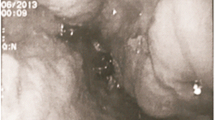Abstract
Although sequelae of chronic liver disease are the most common causes of altered pressure dynamics in the portal and splanchnic circulations, there are other mechanisms resulting in increased venous pressures with subsequent development of splenic and gastric varices. We report a case of a patient without portal hypertension, but with bleeding gastric varices with a presumed splenorenal shunt (SRS) on CT. Venography revealed flow reversal through the shunt (directed from the renal vein, into the splenic vein and out the portal vein; a renal-splent shunt (RSR)) and thus an anatomically similar but functionally distinct systemic to mesenteric variant. While being anatomically similar to the well-known SRS, the different flow dynamics necessitate a different approach for treatment and important considerations for the use of any liquid embolic.



Similar content being viewed by others
References
Saad WEA, Kitanosono T, Koizumi J. Balloon-occluded antegrade transvenous obliteration with or without balloon-occluded retrograde transvenous obliteration for the management of gastric varices: concept and technical applications. Tech Vasc Interv Radiol. 2012;15:203–25.
Sabri SS, Saad WEA. Anatomy and classification of gastrorenal and gastrocaval shunts. Semin Interv Radiol. 2011;28:296–302.
Park JK, Saab S, Kee ST, Busuttil RW, Kim HJ, Durazo F, et al. Balloon-occluded retrograde transvenous obliteration (BRTO) for treatment of gastric varices: review and meta-analysis. Dig Dis Sci. 2015;60:1543–53.
Colle I, Geerts AM, Van Steenkiste C, Van Vlierberghe H. Hemodynamic changes in splanchnic blood vessels in portal hypertension. Anat Rec Hoboken NJ. 2007;2008(291):699–713.
Ishikawa T, Sasaki R, Nishimura T, Matsuda T, Maeda M, Iwamoto T, et al. Liver stiffness measured by transient elastography as predictor of prognoses following portosystemic shunt occlusion. J Gastroenterol Hepatol. 2019;34:215–23.
Hirota S, Kobayashi K, Kako Y, Takaki H, Yamakado K. Balloon-occluded retrograde transvenous obliteration of varices: focusing on the portal hemodynamics and the recent techniques. Hepatol Int. 2018;12:102–11.
Kandpal H, Sharma R, Gamangatti S, Srivastava DN, Vashisht S. Imaging the inferior vena cava: a road less traveled. Radiogr Rev Publ Radiol Soc N Am Inc. 2008;28:669–89
Lee EW, Shahrouki P, Alanis L, Ding P, Kee ST. Management Options for Gastric Variceal Hemorrhage. JAMA Surg. 2019
Srinivasa RN, Majdalany BS, Chick JFB, Meadows JM, Fenlon JB, Brewerton C, et al. Single-session percutaneous endovascular mesocaval shunt creation and balloon-occluded retrograde transvenous obliteration for the treatment of gastric varices. Ann Vasc Surg. 2018;46:371.e1–.e6.
Arabi M, Vellody R, Cwikiel WB, Gemmete JJ. Endovascular treatment of lower gastrointestinal bleeding from systemic-to-mesenteric venous collateral vessels caused by inferior vena cava occlusion: report of two cases. J Vasc Interv Radiol JVIR. 2011;22:1035–8.
Funding
This study was not supported by any funding.
Author information
Authors and Affiliations
Corresponding author
Ethics declarations
Conflict of interest
The authors declare that they have no conflict of interest.
Ethical approval
All procedures performed in studies involving human participants were in accordance with the ethical standards of the institutional and/or national research committee and with the 1964 Helsinki Declaration and its later amendments or comparable ethical standards. Institutional review board approval was obtained. This article does not contain any studies with animals performed by any of the authors.
Informed consent
Informed consent was obtained from all individual participants included in the study.
Consent for publication
Consent for publication was obtained for every individual person’s data included in the study.
Additional information
Publisher's Note
Springer Nature remains neutral with regard to jurisdictional claims in published maps and institutional affiliations.
Electronic supplementary material
Below is the link to the electronic supplementary material.

Supplemental Video: Initial diagnostic power injection venogram revealing high-grade distal IVC stenosis and renal shunt to splenic varices with subsequent hepatopetal flow from varices to the splenic vein and portal vein (AVI 5335 kb)
Rights and permissions
About this article
Cite this article
Jamshidi, N., Kee, S.T. Transcatheter Embolization of Renal–Splenic Shunt to Treat Hematemesis. Cardiovasc Intervent Radiol 43, 1708–1711 (2020). https://doi.org/10.1007/s00270-020-02578-3
Received:
Accepted:
Published:
Issue Date:
DOI: https://doi.org/10.1007/s00270-020-02578-3




